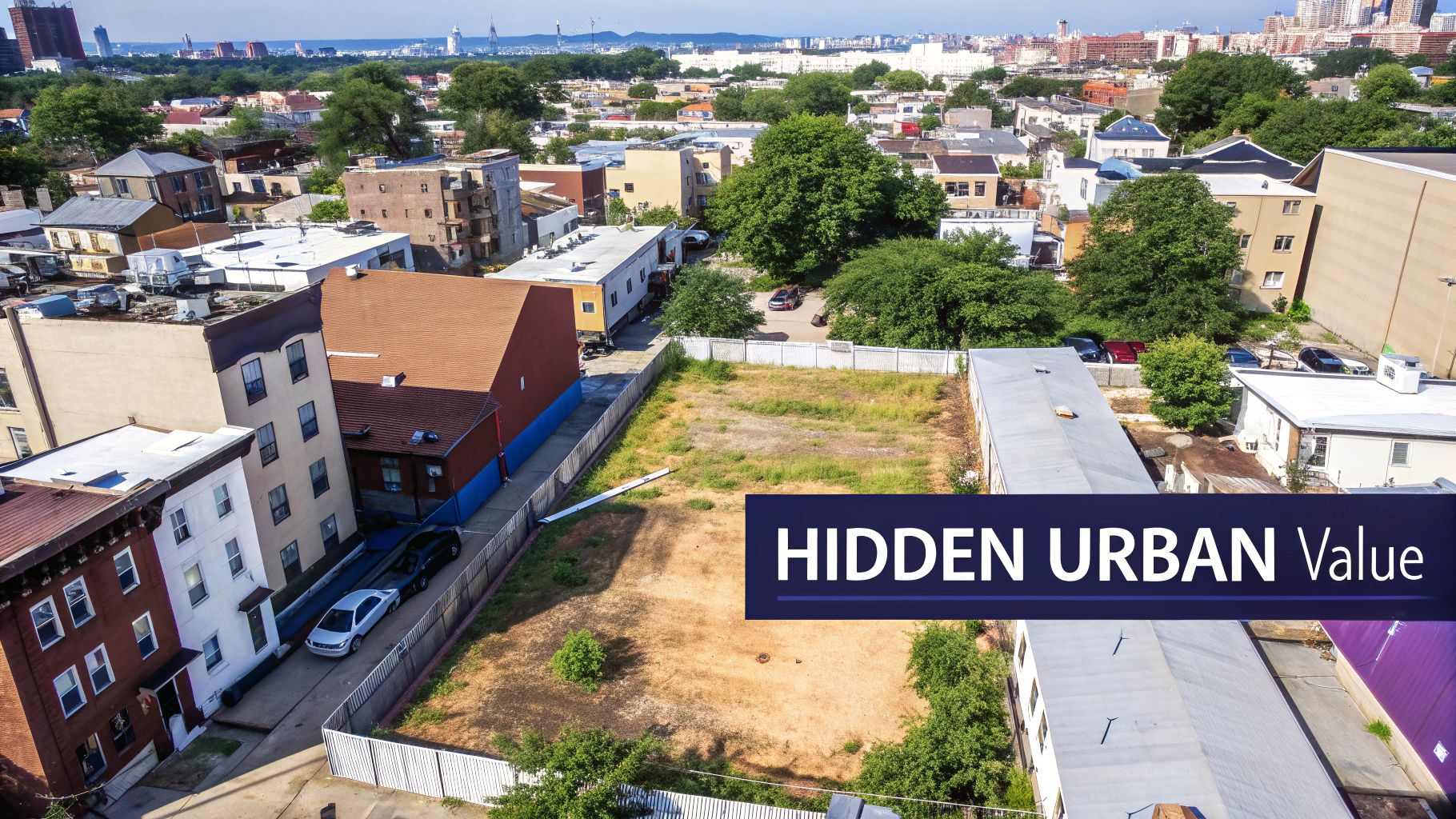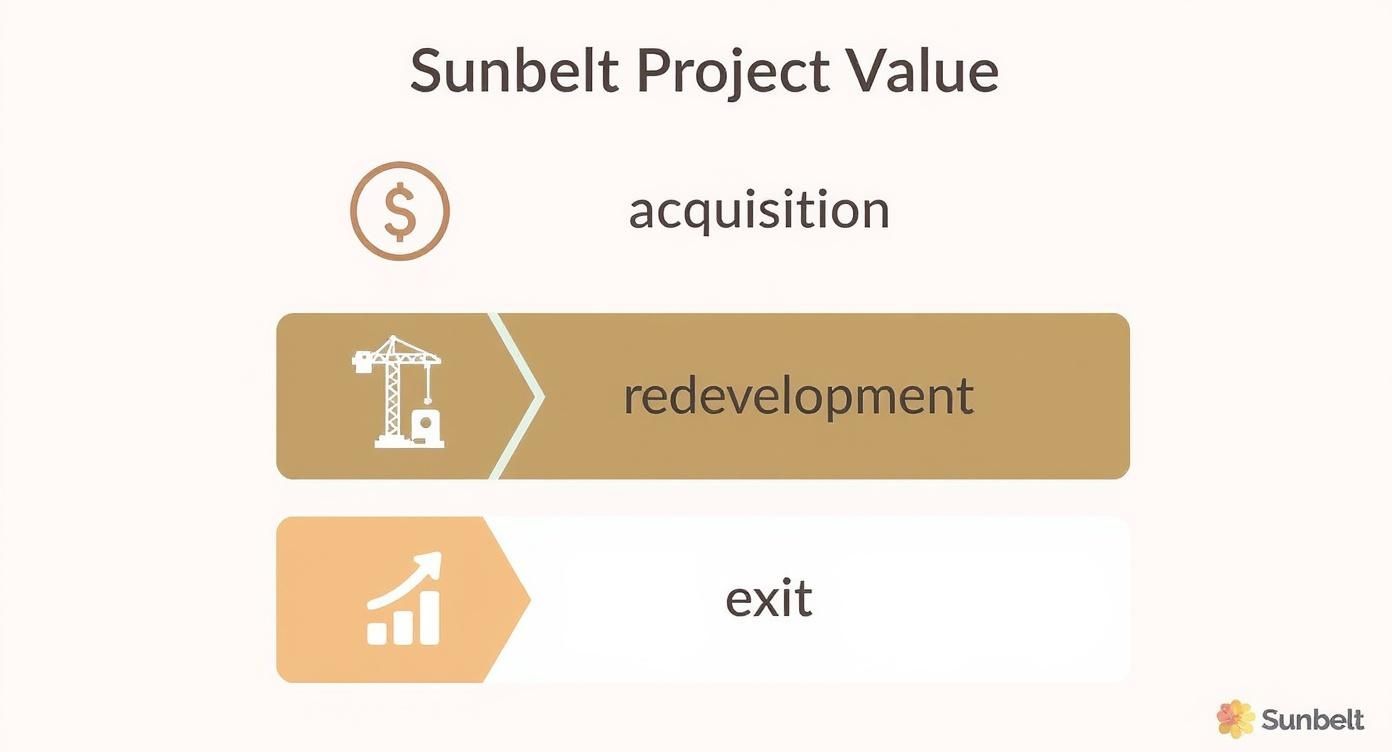What Is Urban Infill? A Guide for Real Estate Investors
- Ryan McDowell

- Oct 25
- 10 min read
Reading Time: 7 min | Good for: Novice & Informed Investors (A, B)
TL;DR: Key Takeaways on Urban Infill Investing
What It Is: Urban infill is the strategy of developing vacant or underutilized land within existing urban areas, capitalizing on established infrastructure and demand.
Why It Matters Now: Strong demographic shifts, particularly migration to Sunbelt cities, are creating a supply-demand imbalance, driving up the value of well-located urban land.
How Investors Participate: High-net-worth individuals and family offices can access institutional-quality infill deals by partnering with specialized sponsors through private equity funds or syndications.
Next Step: Understand the key questions to ask a sponsor to properly diligence an urban infill opportunity.
At its core, urban infill is all about smart, focused growth. Instead of sprawling outward into undeveloped land, it's the strategy of developing vacant or underused parcels of land within an existing urban area.
Think of it like finding a hidden gem—a forgotten lot in a great neighborhood—and polishing it into something valuable, rather than building a new subdivision miles away from the city center. This approach is key to building resilient, valuable real estate portfolios.
Decoding Urban Infill Development

Forget the dense zoning jargon for a moment. Urban infill is really a mindset focused on unlocking value that’s hiding in plain sight. It’s the practice of building new residential, commercial, or mixed-use projects on empty or neglected lots inside already developed areas. This excellent guide offers a solid primer on What Is Infill Development if you want a deeper dive.
This approach is the direct opposite of "greenfield" development, where builders push a city's boundaries into untouched, rural land.
By focusing inward, urban infill takes advantage of the roads, utilities, and transit that are already in place. It's a far more efficient and sustainable model for how cities can grow.
The Market Why-Now: A Spotlight on Infill
Powerful demographic and economic forces are pushing infill development to the forefront. As more people flock to cities, the demand for well-located urban property is exploding. According to the United Nations, 56% of the world’s population lived in urban areas in 2021, a figure projected to rise to 68% by 2050. This massive trend puts a huge premium on any available land within established city cores.
The current market cycle is shining a particularly bright light on infill strategies, especially in high-growth Sunbelt markets. This classic supply-demand imbalance creates a perfect runway for savvy sponsors to:
Acquire underperforming assets in prime locations.
Redevelop them to fit modern needs (e.g., converting outdated retail to medical offices).
Capitalize on rising rents and property values driven by built-in demand.
For you as an investor, this boils down to an opportunity to participate in projects with strong fundamentals. It's a clear path to creating value while playing a direct role in revitalizing urban communities.
The Strategic Payoff of Urban Infill for Your Portfolio
So, we know what urban infill is. But why should it be on your radar? This is where the real investment thesis starts to click. For high-net-worth individuals and family offices, infill projects can deliver a powerful one-two punch of financial upside and strategic advantages that you just don't get with sprawling new developments on the edge of town.

Unlocking Value Where Land is King
The clearest financial benefit comes down to simple economics: land in established, desirable city centers is a finite resource. This built-in scarcity is a massive driver of long-term value.
When a sponsor can acquire an underused lot in these high-barrier-to-entry markets, they can tap into appreciation potential that is often insulated from the whims of the broader market. Better yet, these locations come with a huge advantage baked right in: existing demand.
Close to Jobs: A steady pipeline of high-quality tenants is practically guaranteed.
Walkable Amenities: Proximity to dining, retail, and culture always commands premium rents.
Existing Infrastructure: You're not starting from scratch, which saves millions on building out roads, sewers, and utilities.
For investors, this trifecta means projects often lease up faster and hold higher occupancy rates, translating to more predictable and durable cash flow. Want to dig deeper? You can explore more about these value-creation tactics in our guide on 8 proven strategies to add value to real estate investments in 2025.
The Smart Money is on ESG
More and more, Environmental, Social, and Governance (ESG) principles aren't just a "feel-good" box to check—they are a core part of long-term value creation and smart risk management. Urban infill is a natural fit for a strong ESG strategy.
It's not just theory; it's backed by data. Developing within existing neighborhoods reduces our reliance on cars, a huge win for the environment. By its very nature, infill promotes sustainability and more efficient land use.
Investor Take: According to the U.S. Environmental Protection Agency (EPA), smart growth infill projects are powerhouses for curbing emissions by slashing vehicle miles traveled. In fact, residents in compact, walkable areas can generate about 50% fewer vehicle emissions than those in sprawling suburbs. This isn't just a green initiative; it's a financial one, aligning portfolios with institutional capital mandates.
For any serious investor looking at infill, having a grasp on the broader real estate capital markets—including things like historical CMBS market trends—provides critical context. It reinforces that smart, sustainable development isn't just good for the planet; it's good for the portfolio.
Diving Into the Different Types of Urban Infill Projects
Urban infill isn’t a one-size-fits-all strategy. Think of it more like a spectrum of opportunities, each with its own unique risk/return profile, complexity, and potential return. For investors, understanding where a project falls on this spectrum is key to matching it with your capital and risk appetite.
Small-Scale and Single-Lot Development
This is urban infill in its most granular form. We’re talking about developing a single vacant lot—that classic "missing tooth" in an otherwise complete streetscape—and turning it into a new property. This could be a duplex, a small apartment building, or a sleek new medical office.
These projects tend to move faster and require less capital, often falling into a Value-Add or light development playbook. They have the built-in advantage of plugging directly into the character and amenities of an already established block. To see how these smaller projects often get built, check out our guide on the key modular construction benefits for real estate investors.
Adaptive Reuse Projects
Here, the game changes. Instead of focusing on empty land, we’re looking at existing buildings. Adaptive reuse is all about taking an underused or obsolete structure—an old warehouse, a closed-down school, or a tired big-box store—and breathing new life into it with a higher-value purpose.
This approach is a win-win because it preserves the architectural soul of a neighborhood while meeting modern demands. A forgotten factory can become sought-after loft apartments, while an old retail center can be reimagined as a vibrant mixed-use hub with shops, restaurants, and living space.
Large-Scale Redevelopment
At the most ambitious end of the spectrum, you’ll find large-scale redevelopments. These projects tackle huge parcels of land, like former industrial sites (often called "brownfields") or sprawling, outdated commercial corridors. These are complex, multi-phase Development deals that can fundamentally reshape an entire district.
These ventures often involve public-private partnerships and require significant upfront planning and entitlement work. While they demand significant capital, they also offer the chance for transformative returns by creating entirely new, walkable neighborhoods from the ground up. The potential of this strategy was on full display in the early 2000s, when cities like Denver and Seattle saw a 15–25% increase in infill units, a trend analyzed in this report on the trends in infill housing from the St. Louis Fed.
Deal Lens: How a Sunbelt Infill Project Creates Value
Theory is great, but the numbers tell the real story. To see how an urban infill strategy goes from concept to cash-flowing asset, let’s walk through an illustrative example of a Sunbelt value-add project.
Imagine an old, half-empty retail strip mall on a prime corner in a booming Sunbelt city. The location is a winner—surrounded by new residential developments and a stone's throw from a major employment hub. The problem? The property is tired and failing to keep up.
The Acquisition and Transformation
An experienced sponsor sees the hidden diamond. They acquire the property for $5 million, looking past its current state to what it could become: a vibrant, mixed-use hub that serves the modern needs of the community.
The game plan is a complete transformation.
Total Project Cost: $10 million. This covers the $5M purchase price and a $5M redevelopment budget.
The Vision: Demolish part of the old structure for a modern, three-story building. The ground floor will house high-demand retail and restaurants, while the top two floors will become Class-A medical office suites.
Timeline: The entire redevelopment, from demolition to lease-up, is projected to take 18 months.
This kind of adaptive reuse is a masterclass in smart urban infill. It’s about meeting the market where it’s at today—swapping outdated retail for in-demand medical space—while fundamentally boosting the property’s value and income potential.
Unpacking the Return Drivers
Once stabilized, the revitalized property generates a much higher net operating income (NOI) from premium rents and high-quality tenants. Three years later, the sponsor exits.
Projected Sale Price: $15 million.
Total Profit: $5 million ($15M sale price - $10M total cost).
Key Drivers: Value was created by flawlessly executing the redevelopment, securing strong leases at top-of-market rates, and capitalizing on the neighborhood's continued growth, which compressed the exit cap rate.

Navigating the Common Challenges of Infill Development
While urban infill offers compelling upsides, it's not a strategy for the faint of heart. These projects happen in complex, dense environments, and a disciplined approach to risk is non-negotiable. Understanding potential hurdles—and how a seasoned sponsor plans to clear them—is a critical piece of due diligence.
Risk & Mitigation Table
Risk: Zoning & Entitlement Delays * Mitigation: Engage with city planners and community groups early. Leverage local relationships and a proven track record to streamline approvals.
Risk: Unexpected Site Conditions * Mitigation: Conduct thorough due diligence, including geotechnical and environmental studies, before acquisition. Build a healthy contingency budget (typically 5-10% of hard costs).
Risk: Community Opposition (NIMBYism) * Mitigation: Proactively communicate with neighborhood stakeholders to address concerns and build support. Highlight the project's community benefits, like job creation or blight removal.
Risk: Construction Logistics & Budget Overruns * Mitigation: Partner with contractors experienced in urban construction. Secure guaranteed maximum price (GMP) contracts where possible and maintain a strong contingency fund.
Successfully pulling off these projects requires deep local expertise. If you want to dig deeper into how these projects are funded, check out our guide to commercial real estate financing options for investors.
A sponsor's ability to anticipate and manage these challenges is what separates a successful infill project from a cautionary tale. It’s all about preparation and experience.
Checklist: 5 Questions to Ask an Infill Development Sponsor
Diving deep with due diligence is fundamental to any smart real estate investment. With urban infill projects, you have to dig even deeper. Before committing capital, ask the sharp, specific questions that get to the heart of the opportunity.
A top-tier sponsor will welcome this level of questioning. They should have clear, data-driven answers ready, proving they have a solid grip on their submarket and a disciplined execution plan.
Track Record: Can you provide case studies of at least two similar infill deals you've taken full-cycle? I want to see the original underwriting versus the final returns.
Entitlement Strategy: What’s the specific plan for navigating local zoning and permits? Who are your key relationships at the city that will help facilitate this process?
Community Engagement: How do you plan to get ahead of potential neighborhood opposition ("Not In My Backyard")? What’s your strategy for building local support?
Contingency Planning: What percentage of the total budget is set aside for construction and entitlement surprises, and how did you determine that specific amount?
Underwriting Assumptions: Let's break down your key assumptions for rent growth, exit cap rate, and lease-up velocity. How do those figures compare to current, verifiable market data?
Your Questions About Urban Infill, Answered (FAQ)
How is urban infill different from gentrification?
This is an important distinction. While the two can occur in the same areas, they are not the same concept.
Urban infill is a land development strategy focused on building on vacant or underused parcels within a city.
Gentrification is a socioeconomic shift that can sometimes lead to the displacement of longtime residents as an area's demographics change.
A responsible sponsor aims to enhance a neighborhood, not displace its community. This involves thoughtful design, proactive engagement with local stakeholders, and creating a mix of uses that serve both new and existing residents.
Is urban infill investing only for large institutions?
Not at all. While the largest projects often require institutional-scale capital, accredited investors and family offices have excellent pathways to participate. Private equity firms and real estate syndications are a primary vehicle. These groups pool capital from multiple investors, providing access to institutional-quality deals that would otherwise be out of reach. By partnering with a specialized firm, you co-invest alongside experts, benefiting from their deal flow and operational expertise.
What kind of returns can investors expect?
The honest answer is: it depends entirely on the specific project, market, and strategy. A ground-up development project will target a higher return to compensate for greater risk compared to a simple value-add repositioning. While past performance is never a guarantee, experienced sponsors often target opportunistic internal rates of return (IRRs) and equity multiples that reflect the significant value created through entitlement, construction, and lease-up. It is critical to remember that all private real estate investments carry risk, including the potential for loss of capital.
How does the broader economy impact infill projects?
Economic cycles have a significant impact. Factors like interest rates, the cost of labor and materials, and major demographic shifts all influence a project's viability. Right now, the powerful migration to Sunbelt cities is creating a massive tailwind of demand, making it an ideal environment for infill. A skilled sponsor doesn't just react to these cycles—they anticipate them. They underwrite deals with conservative assumptions, build in robust contingency budgets, and know how to use economic shifts to find mispriced assets where others see only risk.
Well-structured real estate, including urban infill, can be a prudent and resilient component of a long-term wealth strategy. By focusing on high-growth markets and partnering with experienced operators, investors can capitalize on powerful demographic trends while contributing to the sustainable growth of our cities.
Ready to explore how urban infill can fit into your portfolio? Schedule a confidential call with Stiltsville Capital to discuss our disciplined approach to creating value in high-growth Sunbelt markets.
Learn more at https://www.stiltsvillecapital.com.
Information presented is for educational purposes only and does not constitute an offer to sell or a solicitation of an offer to buy securities. Any offering is made only through definitive offering documents (e.g., private placement memorandum, subscription agreement) and is available solely to investors who meet applicable suitability standards, including “Accredited Investor” status under Rule 501 of Regulation D. Investments in private real estate involve risk, including loss of capital, illiquidity, and no guarantee of distributions. Past performance is not indicative of future results.





Comments